Modelling and Visualization of Curved Folding
Abstract
The modelling and the visualization of the curved folded developable surface is necessary in designing a new crease pattern or in learning how to fold the curved folded paper easily. It is also important in industrial applications such as manufacturing of the curved folded metal plate using machines. However, it is not easy to model a developable surface in curved folded shape because the curved surface has the flexibility to change its bending directions. That is, the rulings may transit on the surface as the paper changes its shape.
In this research, we propose some prototypes of a GUI system which model and visualize the curved folding, as described below. The smooth curved surface is represented as a discretized polygon model composed of quad strips divided by the creases and the rulings. The system supports the ruling transition by re-calculating the ruling directions and generating a new surface shape in each time step during the folding motion.
概要
曲線折りによってできる曲面状の可展面のモデリングと可視化は,新たな曲線折り形状の設計,折りやすさの分析,また金属版を用いた曲線折り形状の加工といった工業分野で重要である.しかし,曲面状の可展面は,曲がりの方向の変化により曲面上の線織線が推移し,高い自由度で変形可能であるため,そのモデリングは単純ではない.
本研究では,下記に示すような、曲線折り形状のモデリングと可視化を実現するGUIツールを提案する.曲面を離散的なポリゴンデータで表現し,折り線と線織線をエッジとしてもつ quad strip で構成する.折り動作の生成では,毎時,線織線の方向を再算出し,ポリゴンデータを更新することで,曲がりの方向の変化を伴う変形を再現する。
Curved Folding with One Crease
As the base of our research, we first developed a GUI system to design a curved folding with one curved crease and to simulate its folding motion.Method
The shape of the curved folded surface is calculated according to the curve parameters:- the curvatures,
- the torsions,
- folding angles of the curved crease being folded, and
- the 2D curvatures of the curved crease on the flattened paper.
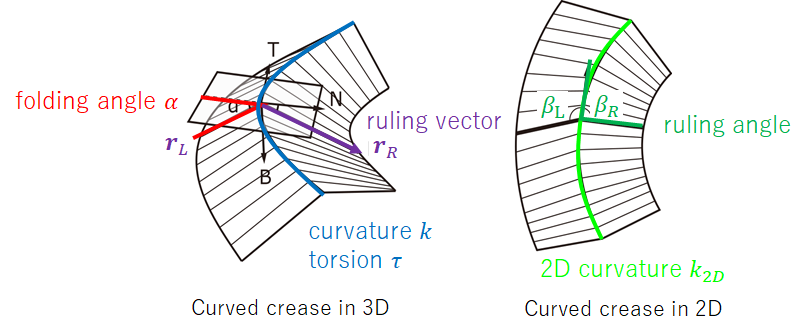
The procedure of designing a curved folded shape.
Result
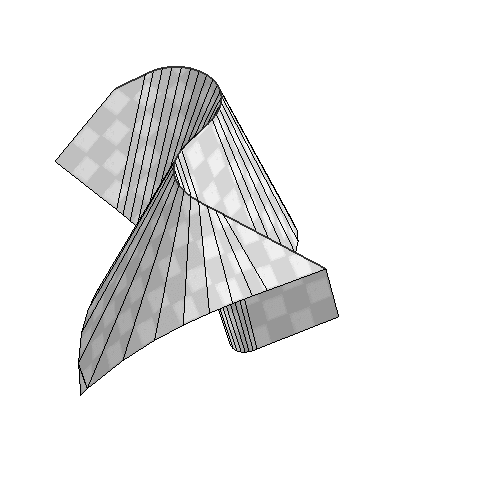 |
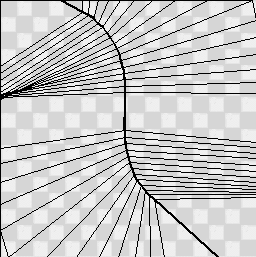 |
 |
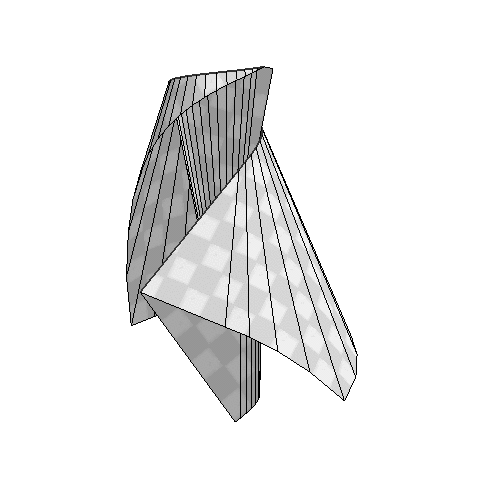 |
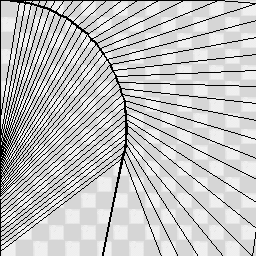 |
 |
Curved Folding with Multiple Creases
As the further development, we developed the user interface to add some curved creases on the curved surface.Method
- On the curved surface with one curved crease, the user draws a curve on the 2D figure.
- The hand-drawn curve is approximated as an Bézier curve with some control points.
- Then the user adjusts the positions of the control points so that the ruling intersection is resolved.
The procedure of adding a crease curve on a curved surface.
Result
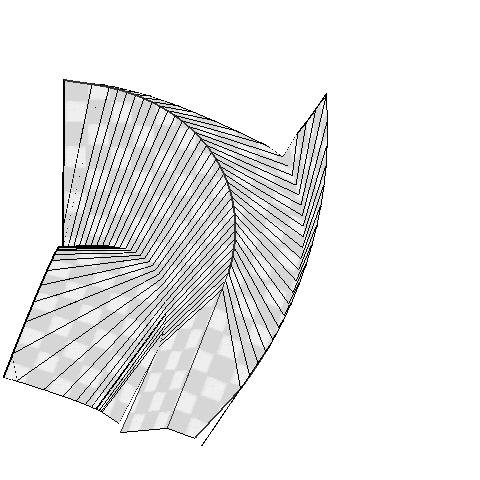 |
 |
 |
Origami Sphere (Rotational Symmetric Curved Folding)
Finally, we propose a method to model a rotational symmetric curved folding, represented by the origami sphere. It is composed of mutiple creases in the shape of lines and curves, intersecting at the center of the paper, which is difficult to model by adding a crease at a time.Method
We realized the modelling of the origami sphere by placing pieces of simple curved surfaces in rotational symmetry, with the boundaries of the adjacent pieces connected to each other. To generate the continuous folding motions, the designer picks some key frames, adjusts the pose and the shape of the piece so that it is connected to the adjacent pieces, and the rest of the frames are interpolated by the curve parameters and the poses.
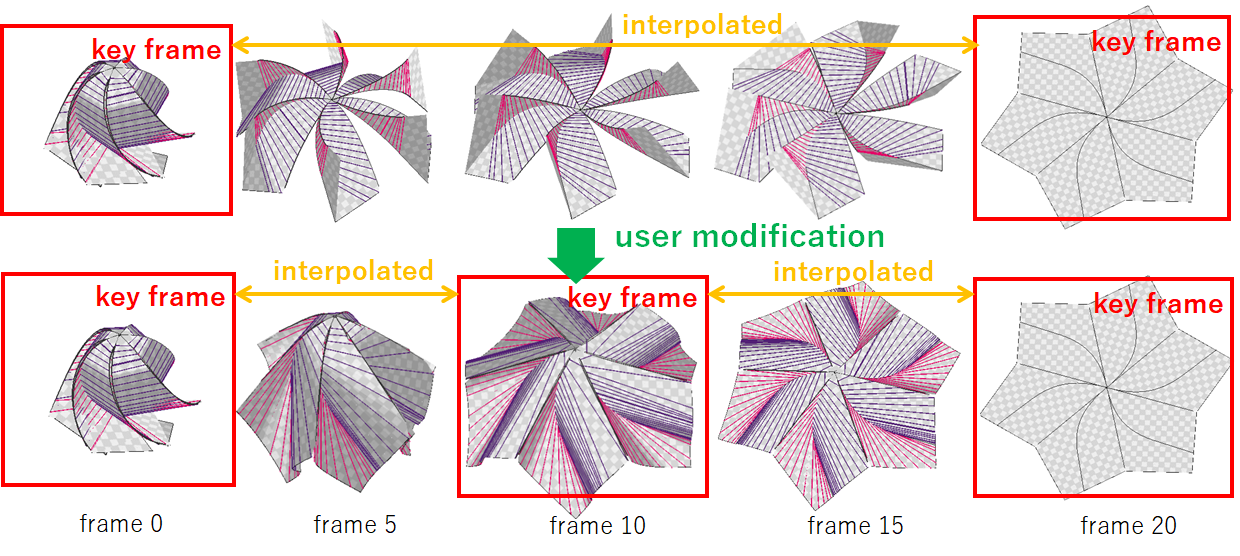
Result
 |
 |
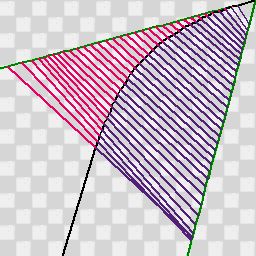 |

Fitting Curved Folded Surface to User Specified Points
In the methods proposed above, the shapes of the curved folded surfaces are designed by manually adjusting the curve parameters. For more intuitive manipulation, we developed an user interface to control the shape by specifying the 3D positions of the surface points.Method
The 3D positions and the surface points are given by the user through the GUI interface or by file input. While the curved crease on the 2D paper is fixed, the folding angles and the torsions are optimized so that the curved surface is folded in the shape as close as possible to the given 3D positions.The procedure of inputting the surface points and their 3D target points.
Publications
国際会議
- Yuka Watanabe, Jun Mitani, "Modelling the Folding Motions of a Curved Fold", in Origami7: Proceedings of the 7th International Meeting on Origami in Science, Oxford, England, September 5-7, 2018, pages 1135-1150.
- Yuka Watanabe, Jun Mitani, "Interactive Modelling of Curved Folds with Multiple Creases Considering Folding Motions", Computer-Aided Design & Applications, 16(3), 2019, 452-465. https://doi.org/10.14733/cadaps.2019.452-465
- Yuka Watanabe, Jun Mitani, "Visualization of Folding Motion of Rotationally Symmetric Curved Folding", Computer-Aided Design & Applications, 17(3), 2020, 513-524. https://doi.org/10.14733/cadaps.2020.513-524
- Yuka Watanabe, Jun Mitani, "Fitting Single Crease Curved-Fold Model to the User Specified Points", Computer-Aided Design & Applications, 19(2), 2022, 387-404. https://doi.org/10.14733/cadaps.2022.387-404
